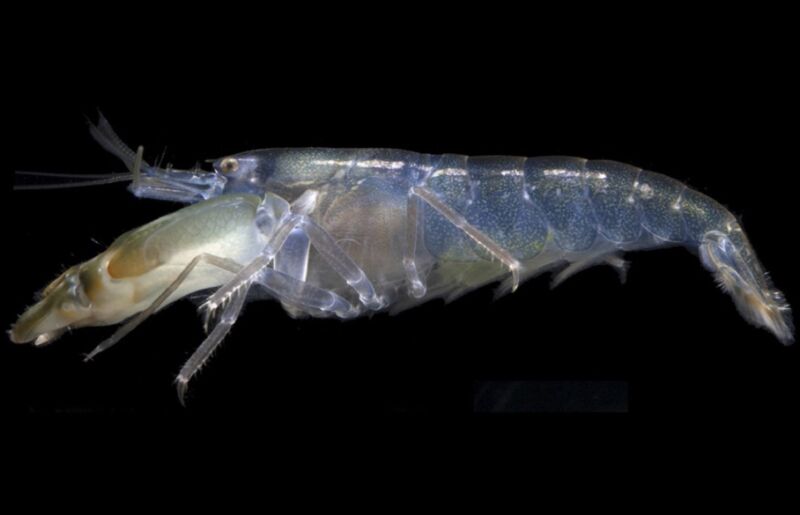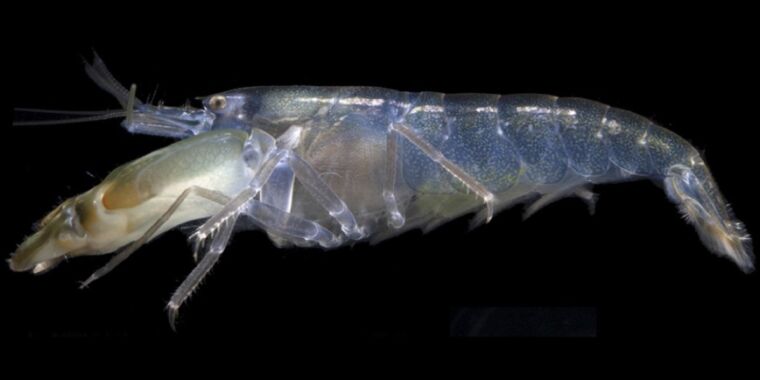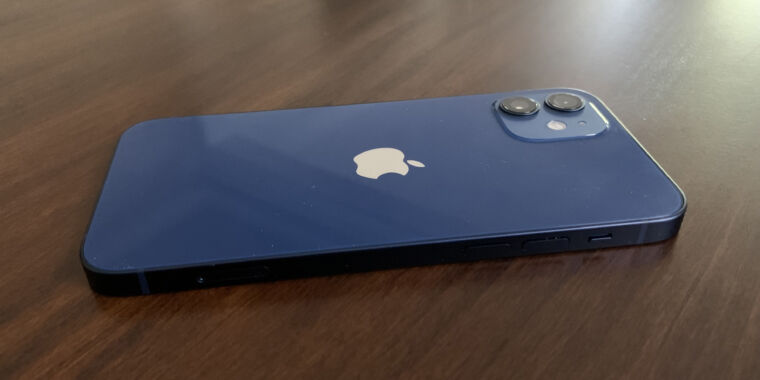
Kingston et al., Current Biology
The tiny-but-mighty pistol shrimp can snap its claws with sufficient force to produce a shock wave to stun its prey. So how come the shrimp appears immune to its sonic weapon? Scientists have concluded that the shrimp is protected by a tiny clear helmet that protects the creature from any significant neural damage by damping the shock waves, according to a recent paper published in the journal Current Biology.
The snapping shrimp, aka the pistol shrimp, is one of the loudest creatures in the ocean, along with the sperm whale and beluga whale. When enough of these shrimp snap at once, the noise can dominate the coastal ocean soundscape, sometimes confusing sonar instruments. The source of that snap: an impressive set of asymmetrically sized claws; the larger of the two produces the snap. As I wrote at Gizmodo in 2015:
Each snapping sound also produces a powerful shock wave with sufficient oomph to stun or even kill a small fish (the shrimp’s typical prey)…. That shock wave in turn produces collapsing bubbles that emit a barely-visible flash of light. It’s a rare natural example of the phenomenon known as sonoluminescence: zap a liquid with sound, create some bubbles, and when those bubbles collapse (as bubbles inevitably do), you get sort bursts of light. I guess you could call it “shrimpoluminescence.”
Scientists believe that the snapping is used for communication, as well as for hunting. A shrimp on the prowl will hide in a burrow or similar obscured spot, extending antennae to detect any passing fish. When it does, the shrimp emerges from its hiding place, pulls back its claw, and lets loose with a powerful snap, producing the deadly shock wave. It can then pull the stunned prey back into the burrow to feed.
Listen to the crackling sounds of pistol shrimp snapping. Credit: AGU.
In 2020, scientists from the Woods Hole Oceanographic Institution announced the results of their experiments with pistol shrimp in tanks in the lab, as well as listening to the shrimp in the ocean at different water temperatures. They concluded that as ocean temperatures rise with climate change, snapping shrimp will snap more often and louder than before. That’s because shrimp are essentially cold-blooded animals, so their body temperature and activity levels will respond to changes in their environment. This would make the global ocean soundscape even noisier.
Alexandra Kingston of the University of Tulsa in Oklahoma and her co-authors on this latest paper were curious about how pistol shrimp could survive the powerful shock waves produced by their claws, which can cause both short- and long-term damage to neural tissue in particular. The shrimp must have protective mechanisms in place, and the team thought the creature’s translucent orbital hood—a helmet-like extension of its exoskeleton that covers the eyes and brain—might be the key. Many species of snapping shrimp have such hoods, but other crustaceans do not.
So Kingston et al. devised a series of shelter-seeking behavioral experiments to test this hypothesis. They divided their laboratory pistol shrimp into four groups. They surgically removed the orbital hoods of two of those groups and left the hoods intact in the other two groups. Snapping shrimp typically retreat to a comfy burrow when they feel threatened or find themselves in an unfamiliar area. Since the shock waves produced by the snap can inflict brain damage, shrimp without the protective hoods should take longer to find their way to a burrow.
In the trials, a group of hoodless shrimp and a hooded group were exposed to three snap-induced shock waves; as a control, a second hoodless group and a second hooded group were not subjected to the shock waves. All four groups of shrimp were then released into one end of the experimental arena, and the team timed how long it took each shrimp to find its way back to the burrow at the other end.
-
Snapping shrimp claw action. 1. closed pistol shrimp claw with hidden plunger (P). 2. open claw with exposed (P) and chamber (C). 3. open claw with water (W) entering (C). 4. claw with (P) pushed into chamber (C), forcing jet stream (J) out of (C).
-
A pistol shrimp with a surgically removed hood
Kingston et al., Current Biology -
Pistol shrimp with protective hood still in place.
Kingston et al., Current Biology
The results: the hoodless shrimp exposed to the shock waves reacted immediately to the snaps, jolting, spinning around, or even falling over, while the intact shrimp did not react at all to the snaps. These hoodless shrimp also took up to seven times longer to make their way to the burrow, compared to the other three groups, and showed signs of disorientation and difficulty controlling their limbs.
What makes the orbital hoods such effective dampeners? The hoods have an opening at the anterior end, and there’s a layer of water between the surface of the hoods’ interior and the shrimp eyes. “We propose that when a shock wave strikes an orbital hood, the rapid changes in pressure cause the water underneath it to be expelled through the anterior opening, away from the head of the shrimp,” the authors wrote. “Through the expulsion of water, some of the kinetic energy of the shock wave may be redirected and released.”
Subsequent experiments bore this out. That makes the pistol shrimp’s orbital hoods “the first biological armor system known to have such a function,” the authors wrote. Kingston et al. think their findings could help design more efficient protective headgear for military personnel or others who work with explosives and other powerful shock waves.
“It’s really hard to stop these pressure waves,” Kingston told New Scientist. “Even things like traditional Kevlar armor don’t stop these shock waves. They can travel through that material. My group is definitely hoping to work with material scientists and engineers, and perhaps the military in the future, to try to engineer something that will be more effective than just protection against secondary [physical] blast injuries.”
DOI: Current Biology, 2022. 10.1016/j.cub.2022.06.042 (About DOIs).








